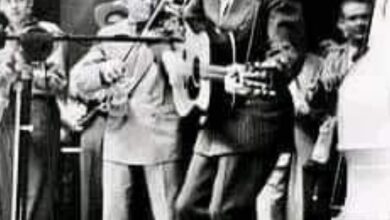The Extraordinary Track ‘I Apologize’ By 15-Year-Old Brenda Lee Enchants Audiences
Brenda Lee’s “I’m Sorry” stands as a hallmark of emotional expression in popular music, transcending the boundaries of age and experience. Released in 1960, this poignant ballad emerged from the creative mind of songwriter Dub Allbach, who crafted lyrics that resonated deeply with feelings of regret and longing. Despite her tender age of only 15, Brenda’s performance was imbued with a level of authenticity and emotional insight that belied her youth. This heartfelt interpretation not only showcased her vocal prowess but also highlighted her ability to connect with the complexities of love and heartbreak, themes that are universal and timeless.
The song became a significant entry in the evolving landscape of music during the early 1960s. It was a period marked by significant cultural shifts, and Brenda Lee’s ability to capture the essence of youthful regret resonated with a generation grappling with its own complexities. As teenagers sought to navigate the realms of love and relationships, “I’m Sorry” became an anthem for those who felt the weight of their own mistakes. The emotional weight of Brenda’s voice, coupled with the poignant lyrics, allowed listeners to feel understood in their moments of sorrow and vulnerability.
Musically, “I’m Sorry” is intricately arranged, employing the lush orchestral sounds that were characteristic of the Nashville sound, a genre that blended country with elements of pop. The orchestration features strings that swell and recede, creating an atmospheric backdrop for Brenda’s commanding vocals. The incorporation of horns and gentle percussion enhances the song’s emotional pull, giving it a sweeping quality that draws the listener in. This production style reflects the prevailing trends of the time, where arrangers layered instruments to amplify the emotional impact of a song and create a rich soundscape.
The success of “I’m Sorry” propelled Brenda Lee into the limelight, solidifying her position as a prominent figure in the music industry. The song reached the top of the Billboard Hot 100, and its impact was further amplified by a Grammy nomination, underscoring her contributions to both pop and country music. Brenda’s ability to navigate both genres seamlessly paved the way for a new generation of artists who would follow in her footsteps, showing that the intersection of these musical styles could create powerful and lasting art. Not only did it showcase her vocal range, but it also revealed her sensitivity as an artist willing to delve deep into the emotions that drive human connections.
As a cultural icon, Brenda Lee’s influence extends beyond just individual songs. She became a part of the fabric of 1960s music, performing alongside legends and contributing to the evolution of sound during that era. Her youthful image, combined with her maturity as an artist, captivated audiences of all ages. This duality allowed her to maintain relevance in an industry that often favors youth, as she continued to release hit songs throughout her career, establishing a legacy that would influence countless artists. In an industry where many successes can be fleeting, Brenda’s musical career has demonstrated remarkable longevity, highlighted by numerous hits and performances across decades.
In addition to “I’m Sorry,” Brenda Lee produced several other notable tracks, including “Rockin’ Around the Christmas Tree,” which has become a perennial holiday favorite. This song, like “I’m Sorry,” showcases Brenda’s versatility and ability to evoke emotion through her singing. Her crossover appeal allowed her to become one of the few female artists who could thrive in both the pop and country music scenes, bridging the gap between the two genres and expanding her audience reach. The joyful nostalgia captured in “Rockin’ Around the Christmas Tree” contrasts the sorrow of “I’m Sorry,” illustrating her remarkable ability to navigate varying emotional landscapes in her music.
Brenda Lee’s journey in the music industry is marked by resilience and dedication. She faced challenges and changes in musical trends but consistently managed to adapt while staying true to her artistic core. Her success story is not just about her hits but also about her determination to connect with her audience through sincere songwriting and captivating performances that leave a lasting impression. Her dedication to her craft is evident in her ongoing performances, where her rich voice continues to resonate, allowing old songs to find new life with contemporary audiences.
Over the years, Brenda Lee has received numerous awards and honors that celebrate her contributions to music. Inductions into various halls of fame and recognition from her peers underscore her status as a respected artist. Brenda’s legacy is one of inspiration, demonstrating that powerful vocal talent coupled with genuine emotion can create songs that resonate for decades. The recognition she has garnered reflects the impact of her work, not just in terms of commercial success, but in the emotional connections she has fostered through her music.
As she continues to perform and engage with fans, Brenda Lee embodies the essence of a true artist who understands the power of music in expressing human emotions. Her journey illustrates how one song can change a career and how that career can, in turn, influence generations of music lovers and aspiring musicians. Each performance becomes a reminder of the timeless quality of her songs—originating from a place of authenticity, they touch the hearts of listeners across age groups. The emotional depth of “I’m Sorry” and its timeless appeal ensure that Brenda Lee will always be remembered not just for her chart-topping hits but as a pioneer in the landscape of American music.
Reflecting on Brenda’s career reveals a tapestry of musical evolution paralleling societal changes. As youth music culture expanded in the 1960s, Brenda’s songs often echoed the trials and triumphs of a generation in transition. “I’m Sorry” serves as an emotional touchstone, capturing a moment in history where personal connections felt deeply intertwined with public sentiment. Brenda’s unique ability to convey such intimacy through her music makes her an enduring figure, whose songs resonate with the feelings of many long after their release.
Brenda Lee’s contributions to music exemplify the intersection of artistry and emotional expression. Her blend of heartfelt narratives with compelling melodies captivates the listener’s experience, allowing her songs to linger well beyond the final note. As new generations discover her music, the themes of love, regret, and happiness continue to flourish, affirming her legacy as one of the great voices in American music history. Ultimately, Brenda Lee’s journey illustrates the profound impact of a single song and the artist’s commitment to exploring the depths of human experience.





